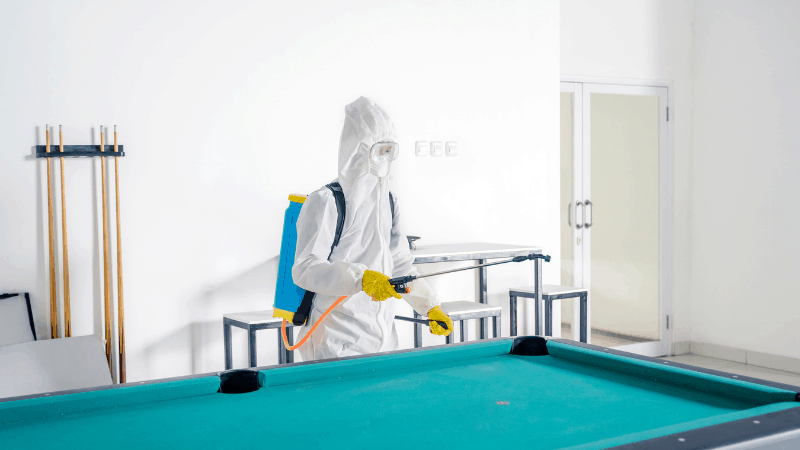In addition to being the gateway to countless billiards games, a pool table can be an eye-catching staple piece to any room. However, its visual impact and your gameplay can be significantly tarnished if your pool table isn’t in pristine condition. Considering how expensive pool tables can be to acquire as well as repair, you’ll want to do everything within your power to keep it looking brand new for as long as possible.
In this article, we’ll detail ten ways you can keep your pool table in pristine condition. These tips range from regular maintenance routines to preventative tips. So, read on if you want to guarantee your pool table looks and functions at its best for years without the extra cost of component repairs or replacements.
Brush Your Pool Table Once a Week
One of the first steps to keeping your pool table in pristine condition is regular cleaning, starting with the tabletop.
It doesn’t take much to damage a pool table’s felt and allowing dirt, dust, and other debris to linger on the material will cause it to disintegrate or fade over time. The best way to prevent this is to brush it after every game.
Pool table brushes are a cheap but necessary investment for your table’s maintenance. When you clean the tabletop, make sure you brush all particles in one direction towards the pocket. Do so lightly to ensure you don’t push any debris into the material rather than off the table.
Alternatively, you can use a vacuum equipped with an upholstery-friendly attachment and low suction power to remove deeper set debris.
Cover Your Pool Table When It Isn’t Being Used
The more your pool table is exposed to the elements or anything in its immediate surroundings, the greater its risk of being damaged in some way.
Dust, sunlight, moisture, and pests are all things that could cause your table to deteriorate in between games. An easy way to protect your beloved table from all of this is by investing in a decent pool table cover.
While some of these table covers can be a bit pricy, ranging from $50-$150+, we promise that having your table professionally reflected is going to cost you much more. So, do yourself a favor and don’t skimp on this preventative measure. Get your pool table the cover it deserves, and make sure it is on whenever you aren’t playing a game.
Never Leave the Pool Balls on the Table
While it might be convenient to store your pool balls within their rack on top of your table so they’re ready for the next game, this could cause irreversible damage to the tabletop.
Pool balls can create small indentations in the felt on your tabletop and can even cause cloth discoloration depending on how long they’ve been sitting there, how dirty the balls are, and if the table is exposed to any sources of light.
It’s always best to store your pool balls when they aren’t being used. We recommend placing them in a case or a wall rack. Refrain from storing them in the pool table pockets, as the weight of the balls will stretch out the pocket’s material and might pull out some of its fastening staples or pins.
Don’t Use the Pool Table for Anything Except Playing Pool
This might sound obvious, but you’d be surprised how many people repurpose their pool table for other things. The purpose of a pool table is self-explanatory- to play pool and for that reason alone.
Using your pool table for anything other than its intended purpose only increases the risk of damaging it. Don’t use it to store drinks and food for your upcoming party. Don’t use it to play poker with your friends. And you definitely shouldn’t use it as a bench or a bed.
Even if your table is covered, it should be left in peace if you don’t intend to use it for a billiards game. The money you’d most likely spend to repair any damages inflicted when using it for other reasons would have been better spent buying a basic table for cheaper.
Keep Table Movement to a Minimum
One reason pool tables are so expensive is that they are hefty pieces of equipment that can easily weigh anywhere from 700 to 1,000 pounds. Because of this, they’re typically installed and moved in pieces rather than as a whole.
Moving your pool table could easily alter the bumper’s alignment, leave the slate un-leveled, or damage other components. This is, in addition to its sheer weight, is why it is advisable to only allow professionals to move a pool table.
If you need to move your pool table a few inches or so, you can employ the help of several friends or family members to help you manage the weight, but recognize you are risking the table’s condition. Try to only move the table when necessary, and if it needs to be moved a significant distance, contact a professional for the task.
Utilize Proper Playing Techniques
We recognize there’s always a learning curve with pool, and beginners are bound to make some mistakes, but we highly recommend you do your best to utilize proper technique and take your time when playing on your pool table.
The most common cause of damage on a pool table is skid marks, rips, and holes created by a cue stick that’s missed the mark. For experienced players, this usually occurs when testing trick shots, so we recommend you keep this to a minimum.
For newer pool players, ensure that you always keep your stick level with the table when shooting. That way, even if you miss, your stick should just pass the ball instead of digging into the table.
Another precaution you might want to take is allowing novices to shoot using a bridgehead or stick. This will help keep their sticks level and stable, effectively reducing the odds of missing the ball completely and scraping the tabletop with their pool stick.
Clean All Pool Accessories and Table Components Regularly
There are many parts to a pool table, and if you want to keep it in pristine condition for as long as possible, you’re going to need to clean them all regularly.
Here are the parts and accessories of a pool table and how each should be cleaned:
| Pool Table Component/Accessory | Ideal Cleaning Method |
| Table frame | · Use a soft brush on flat surfaces, rail, legs, and cabinet to remove dust and debris.
· Use a soft, dry cloth and the appropriate polish for each part’s material · Use wood cleaner for scuffs and marks · Condition wood with wood cleaner |
| Pool balls | · Wipe down with a dry, microfiber towel |
| Pool Cue Sticks | · Wipe down with a dry, microfiber towel
· Polish occasionally with wood cleaner · Replace tips when necessary |
| Pockets | · Wiped down with a dry, microfiber towel or use a vacuum
· If they’re made with leather, condition them occasionally with oil-based cleaner |
Keep Contaminants Away from the Pool Table
This one’s pretty simple; the less that comes into contact with your pool table, the better. Therefore, make sure you keep common contaminants like food and beverages away from the table at all times.
Additionally, it’s best to chalk your pool cue sticks away from the table, as chalk can be extremely tricky to brush or vacuum out of the felt tabletop.
You’ll also want to refrain from smoking in the same room as your pool table since the cigarette butts or ashes could fall onto the felt, and the smoke itself can seep into the table’s materials and damage them. Also tempting while playing pool… adult beverages. But these beer and cocktails leave stains when they’re spilled. And they always seem to get spilled.
Place Your Table in a Dimly Lit Room
Any form of light can damage your pool table, but sunlight is the most dangerous. If your table is left exposed to light sources for extended periods, you’ll most likely find your cloth has faded, and the table’s finished has been bleached.
While covering your table when it isn’t in use can help prevent unnecessary light exposure, it won’t do much when you’re using your table. Therefore, we recommend placing your table in a dimly lit room or in a location where it won’t be exposed to excessive sunlight. If the table has to be placed in a bright room, consider investing in some blinds to help keep it in the dark.
Maintain a Humidity Level of 40%-60%
Most pool tables (the nicer ones anyways) are made with high-quality woods and leather, which will become dry and crack if they are left in a room with minimal moisture.
The optimal humidity level for pool tables using these materials is somewhere between 40-60%. This can be difficult to maintain if you live in a region with frigid winters, arid deserts, or high-altitude climates.
In that case, you’ll want to have a humidifier in your pool room that can help keep the moisture levels at an optimal percentage for your table’s protection.

